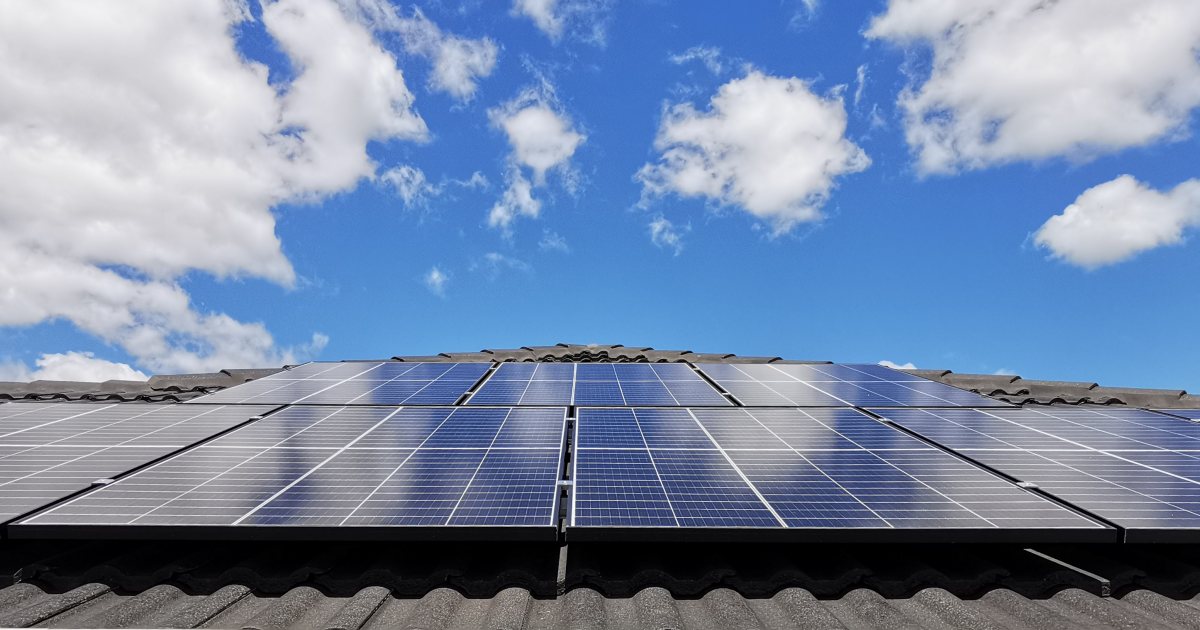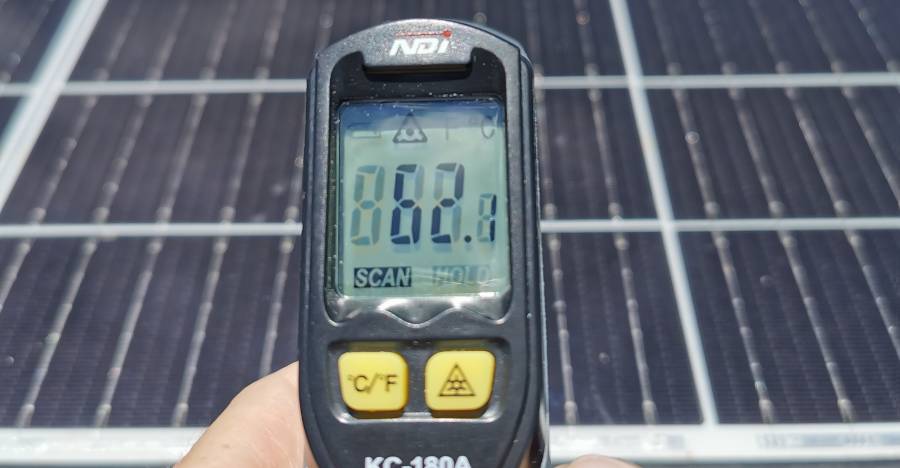
Things got pretty toasty here in Adelaide on Tuesday. Discover the impact it had on our solar power system’s performance.
Our system is comprised of just under 10kW of solar panels (9.96kW), an 8.2kW inverter and is export limited to 5kW. As it’s reasonably new, I’ve been keeping fairly close tabs on what it’s doing. And as heat is the enemy of solar panel efficiency, I was particularly interested in what would happen on very hot day.
I recently wrote about how the system performed on Xmas day when we were graced with the presence of 19 guests requiring cooling by our aging air-conditioner. It was what most would consider a hot day at 34 degrees, but mild compared to what was to come over the next couple of days.
Monday At 37.4°C
At around 2.20 pm on Monday, the temperature outside had reached 37.4°C. Armed with my trusty ladder and an infrared thermometer, I took a reading of the solar panels, which were sitting at around 55.2°C. As panels will often be 20°C above ambient, this was a little on the “cool” side – probably helped by a bit of breeze.
Solar panel wattage ratings are based on a Standard Testing Condition (STC) of 25°C module temperature (not ambient). Above that and they start to lose efficiency1. How much they lose varies from model to model, but more on that in a bit.
At that point, the inverter was cranking 8.185 kW; so just a smidge under its maximum capacity of 8.2 kW.
Nice!
Tuesday At 41°C
Tuesday was hotter. At around 2 pm, the temperature had reached 41°C. Back on the ladder and another temperature reading: 62.1°C this time around.
We have Trina solar panels – the Vertex S+. Trina states the Vertex S+ have a temperature coefficient of Pmax of -0.30%/°C. This means for each degree above 25°C, the panels lose -0.30% of their rated capacity. And the difference in this case was 37.1 degrees above 25°C.
So: 37.1 x .3 = 11.13% expected capacity loss (~1.1kW) = ~8.85kW capacity after loss.
Bearing in mind I have an 8.2 kW inverter, meaning that is the maximum it will output, I’ll need to take Trina at its word on this. With regard to the inverter’s performance, at that point it was ticking along at around 8.12 kW output – again, not much under its maximum capacity.
Choosing An Inverter Installation Location
We have a Fronius inverter – a Primo 8.2-1.
Many inverters use passive (aka “natural” or convection) cooling. One of the great things about the Fronius Primo inverter is it has active cooling – a fan; the speed of which ramps up and down depending on temperature. This feature helps to maintain performance in hot conditions.
One of the not-so-great things about the Fronius Primo is it has a fan, which can be rather noisy. The following video was taken around the time I took panel temperature readings when the inverter was working really hard. I was standing back around 3 metres from the inverter, but zoomed in.
Our inverter is installed in the garage (which seems to amplify the sound) and is around 90 cm away from a door. On the other side of that door and behind the brick wall the inverter is hanging on is our front lounge. While I could hear the fan in the lounge, the sound level wasn’t to the point of distraction (or regret) in my opinion. But it is noticeable and it’s a room we don’t use a great deal – not because of the inverter.
Fronius Gen24 inverters also have a powerful fan; but from what I’ve read they aren’t as loud as the Primo.
By the way, installing a solar inverter (regardless of type) out of direct sunlight is strongly recommended. It may also be required under warranty. Inverters are the workhorse of a solar power system and have a hard enough life without having to contend with the harsh Australian sun beating down on them day-in, day-out. If you don’t have a shady spot, various shade devices and inverter covers are available.
Solar Power In The Heat – No Sweat
This was an interesting exercise and thanks to having an “oversized” system using a good quality inverter, there was very little impact on maximum output compared to ideal conditions.
If your solar power system is appropriately sized, has good components and has been competently installed; don’t be concerned about particularly hot days. In a more detailed article, SQ’s Ronald explains why you shouldn’t worry about heat impact on solar energy output.
Footnotes
- As panels age, they also very slowly lose some efficiency and that’s where “oversizing” a system – where panel capacity exceeds inverter capacity – also comes into play. ↩


 RSS - Posts
RSS - Posts



No Brasil existem painéis solares que parou de funcionar. Painéis solares em telhado de zinco sem espaço entre painel e telhado. Temperatura 65 graus acima de 25°C. Assim: 40ºC x 0,4 = 16% de perda de capacidade esperada. Inversor 8KW x 0.84% = 6.72 KW. Isso é um absurdo erro de projeto.
Translation: “In Brazil there are solar panels that stopped working. Solar panels on a zinc roof with no space between panel and roof. Temperature 65 degrees, 40 above 25°C. Thus: 40ºC x 0.4 = 16% loss of expected capacity. Inverter 8KW x 0.84% = 6.72 KW. This is an absurd design error.”
A 16% loss is not the end of the world, but agree that there should always be at least a 100 mm air gap between panels and roof to help keep the panels cool.
Not sure why you would have 10KW of panels with an 8KW inverter for 5KW?
I suppose you will be installing a battery system?
Otherwise the sizing makes no sense.
The sizing makes a lot of sense. It is smart solar design within the constraints of the DNSP’s rules.
Assume 10 kW of panels and a 10 kW inverter. This will probably never produce 10 kW – due to losses.
So the 8 kW inverter makes sense. If you run the numbers, this design has negligible solar curtailment over 12 months, so why pay extra for a 10 kW inverter?
Now let’s move to the 5 kW export limit. 5 kW is mandated by the local DNSP, SA Power Networks. This is a smart design – compared to the implied alternative: a 5 kW inverter with a 5 kW export limit.
Ronald has done the maths here:
The thing about solar is that ‘curtailment is a feature – not a bug’. It is smart to design some or even plenty of curtailment into the system because extra solar panels are so cheap to install when the installers are on your roof.
OK Finn.
I live in QLD and I have had solar from 2008. My first inverter was a Sunnyboy 5KW and now I have a SolarEdge Energy Hub with a 10KW battery.
The panels I run are rated 6.6KW and they have produced far above that through the SolarEdge 5KW inverter. The battery is the key because the panels are unrestricted having their excess going to the battery. I have seen instantaneous outputs above 8KW on cold days in spring. This over production is consistent – not rare as your other article says (I can give you plenty of evidence to back this up). This is because they are operating 5-6degrees below the rated 25 degrees used for bench marking.
I suppose it depends on what you are trying to achieve but I would have thought 10KW panels and a 8KW inverter for a 5 KW export was overkill. Even the graphs in your other article confirms this. Cost for the extra capacity (inverter +panels) are not factored in your other article. Where is the cost/benefit?
Hi Richard – we’re likely getting a getting an electric car soon; and have some other plans for making better use of the system.
Hi Michael,
Please don’t take my comments personally. I am seeking to expand my own knowledge, not trying to criticise other’s choices.
If you purchase an EV particularly with V2G (vehicle to grid) I think that is a fantastic decision and fully justifies a 10KW>8KW system.
Having an EV as a house power supply and transport is the ultimate expression of energy self sufficiency and efficiency.
Please keep us posted of your developments.
I have recently had installed a 15.35 kW system with Trina Vertex S+ panels and a Goodwe 15kW inverter. I’m on 3 phase hence the larger setup, and also live in Adelaide.
On that particular day the 27th of December my system only generated 64.50 kWh for the entire day. And in the month I have had it installed I have never seen any more than about 9.1kW generated at the high point of the day.
My maximum production generated on any day since installation is about 71kW, which is a bit disappointing given the fact that it was forecast that the system would produce about 100kW per day in the height of summer.
Me system is 11kw and frequently produces 10.2kw ,and around 75-76kw/h per day, something is off in your system. Cheers